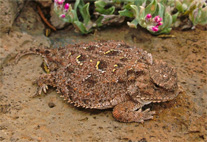Abstract
Short-horned lizards (Phrynosoma douglasii species complex) occur throughout the inter-montane West and Great Plains of western North America. The comparative morphology and color pattern variation of short-horned lizards was studied in 3,174 specimens. Multivariate analyses of 20 morphological and color-pattern characters were applied to 977 specimens, and univariate statistics were summarized for 52 samples totaling 1,134 specimens. The results of the morphological data analyses support the recognition of P. douglasii (Bell 1828) as a distinct species, and the resurrection of P. brevirostris Girard 1858a and P. ornatissimum Girard 1858a as species distinct from P. hernandesi Girard 1858a. Two new species allied to P. brevirostris are described: P. bauri sp. nov. from the eastern plains of Colorado and northeastern New Mexico, southeastern Wyoming and southwestern Nebraska south of the North Platte River, and P. diminutum sp. nov. endemic to the San Luis Valley of southern Colorado and northern New Mexico. The Mexican taxon brachycercum Smith 1942 is reassigned as a subspecies of P. ornatissimum, based on non-discrete character differences and overall morphometric similarity. The ranges of P. hernandesi and P. ornatissimum broadly overlap in central New Mexico, the former taxon occupying the coniferous forests of disjunct mountain ranges, the latter occuring in the surrounding desert grasslands. Principal components analysis has revealed morphological evidence of hybridization where the two taxa meet, generally within ecotones between montane forest associations and grasslands. Principal components analysis has also revealed a high level of morphological variability in populations occurring in the Colorado Plateau region of northeastern Arizona, northwestern New Mexico, extreme southwestern Colorado and adjacent Utah. The evidence suggests that these populations arose through past hybridization between the two species. The taxon ornatum Girard 1858b, although sharing several traits with P. brevirostris, is morphologically close to P. hernandesi. It is regarded as a stabilized population of hybrid origin, but treated taxonomically as a subspecies of P. hernandesi. The taxonomic arrangement in this study, with the exception of P. douglasii, is largely discordant with the proposed taxonomy from a previously published study based on mitochondrial DNA sequence data.

